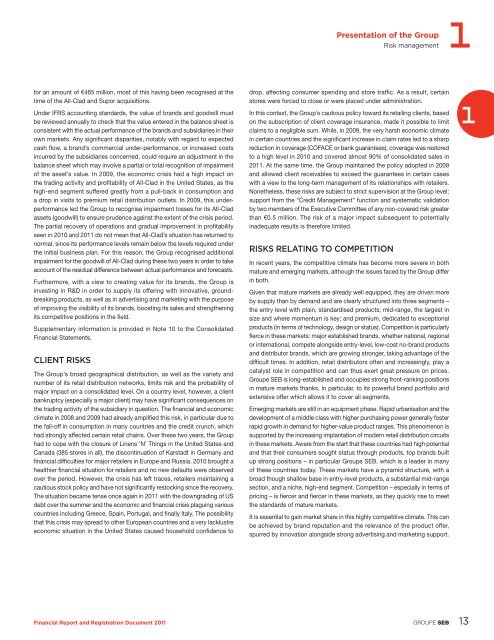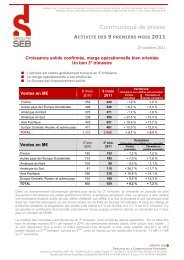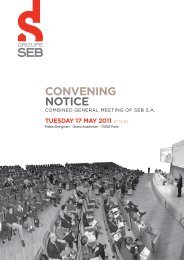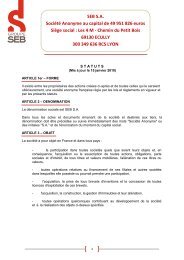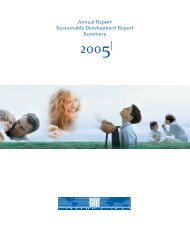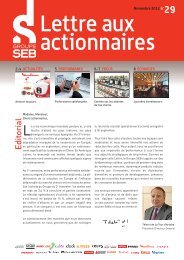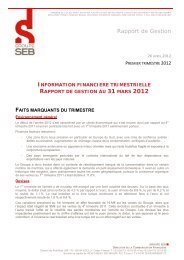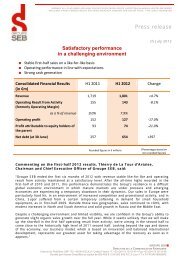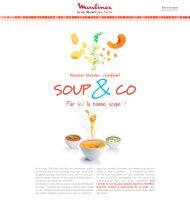financial report and registration document 2011 - Groupe SEB
financial report and registration document 2011 - Groupe SEB
financial report and registration document 2011 - Groupe SEB
Create successful ePaper yourself
Turn your PDF publications into a flip-book with our unique Google optimized e-Paper software.
for an amount of €465 million, most of this having been recognised at the<br />
time of the All-Clad <strong>and</strong> Supor acquisitions.<br />
Under IFRS accounting st<strong>and</strong>ards, the value of br<strong>and</strong>s <strong>and</strong> goodwill must<br />
be reviewed annually to check that the value entered in the balance sheet is<br />
consistent with the actual performance of the br<strong>and</strong>s <strong>and</strong> subsidiaries in their<br />
own markets. Any signifi cant disparities, notably with regard to expected<br />
cash fl ow, a br<strong>and</strong>’s commercial under-performance, or increased costs<br />
incurred by the subsidiaries concerned, could require an adjustment in the<br />
balance sheet which may involve a partial or total recognition of impairment<br />
of the asset’s value. In 2009, the economic crisis had a high impact on<br />
the trading activity <strong>and</strong> profi tability of All-Clad in the United States, as the<br />
high-end segment suffered greatly from a pull-back in consumption <strong>and</strong><br />
a drop in visits to premium retail distribution outlets. In 2009, this underperformance<br />
led the Group to recognise impairment losses for its All-Clad<br />
assets (goodwill) to ensure prudence against the extent of the crisis period.<br />
The partial recovery of operations <strong>and</strong> gradual improvement in profi tability<br />
seen in 2010 <strong>and</strong> <strong>2011</strong> do not mean that All-Clad’s situation has returned to<br />
normal, since its performance levels remain below the levels required under<br />
the initial business plan. For this reason, the Group recognised additional<br />
impairment for the goodwill of All-Clad during these two years in order to take<br />
account of the residual difference between actual performance <strong>and</strong> forecasts.<br />
Furthermore, with a view to creating value for its br<strong>and</strong>s, the Group is<br />
investing in R&D in order to supply its offering with innovative, groundbreaking<br />
products, as well as in advertising <strong>and</strong> marketing with the purpose<br />
of improving the visibility of its br<strong>and</strong>s, boosting its sales <strong>and</strong> strengthening<br />
its competitive positions in the fi eld.<br />
Supplementary information is provided in Note 10 to the Consolidated<br />
Financial Statements.<br />
CLIENT RISKS<br />
The Group’s broad geographical distribution, as well as the variety <strong>and</strong><br />
number of its retail distribution networks, limits risk <strong>and</strong> the probability of<br />
major impact on a consolidated level. On a country level, however, a client<br />
bankruptcy (especially a major client) may have signifi cant consequences on<br />
the trading activity of the subsidiary in question. The fi nancial <strong>and</strong> economic<br />
climate in 2008 <strong>and</strong> 2009 had already amplifi ed this risk, in particular due to<br />
the fall-off in consumption in many countries <strong>and</strong> the credit crunch, which<br />
had strongly affected certain retail chains. Over these two years, the Group<br />
had to cope with the closure of Linens ’N’ Things in the United States <strong>and</strong><br />
Canada (385 stores in all), the discontinuation of Karstadt in Germany <strong>and</strong><br />
fi nancial diffi culties for major retailers in Europe <strong>and</strong> Russia. 2010 brought a<br />
healthier fi nancial situation for retailers <strong>and</strong> no new defaults were observed<br />
over the period. However, the crisis has left traces, retailers maintaining a<br />
cautious stock policy <strong>and</strong> have not signifi cantly restocking since the recovery.<br />
The situation became tense once again in <strong>2011</strong> with the downgrading of US<br />
debt over the summer <strong>and</strong> the economic <strong>and</strong> fi nancial crisis plaguing various<br />
countries including Greece, Spain, Portugal, <strong>and</strong> fi nally Italy. The possibility<br />
that this crisis may spread to other European countries <strong>and</strong> a very lacklustre<br />
economic situation in the United States caused household confi dence to<br />
Financial Report <strong>and</strong> Registration Document <strong>2011</strong><br />
1<br />
Presentation of the Group<br />
Risk management<br />
drop, affecting consumer spending <strong>and</strong> store traffi c. As a result, certain<br />
stores were forced to close or were placed under administration.<br />
In this context, the Group’s cautious policy toward its retailing clients, based<br />
on the subscription of client coverage insurance, made it possible to limit<br />
claims to a negligible sum. While, in 2009, the very harsh economic climate<br />
in certain countries <strong>and</strong> the signifi cant increase in claim rates led to a sharp<br />
reduction in coverage (COFACE or bank guarantees), coverage was restored<br />
to a high level in 2010 <strong>and</strong> covered almost 90% of consolidated sales in<br />
<strong>2011</strong>. At the same time, the Group maintained the policy adopted in 2009<br />
<strong>and</strong> allowed client receivables to exceed the guarantees in certain cases<br />
with a view to the long-term management of its relationships with retailers.<br />
Nonetheless, these risks are subject to strict supervision at the Group level:<br />
support from the “Credit Management” function <strong>and</strong> systematic validation<br />
by two members of the Executive Committee of any non-covered risk greater<br />
than €0.5 million. The risk of a major impact subsequent to potentially<br />
inadequate results is therefore limited.<br />
RISKS RELATING TO COMPETITION<br />
In recent years, the competitive climate has become more severe in both<br />
mature <strong>and</strong> emerging markets, although the issues faced by the Group differ<br />
in both.<br />
Given that mature markets are already well equipped, they are driven more<br />
by supply than by dem<strong>and</strong> <strong>and</strong> are clearly structured into three segments –<br />
the entry level with plain, st<strong>and</strong>ardised products; mid-range, the largest in<br />
size <strong>and</strong> where momentum is key; <strong>and</strong> premium, dedicated to exceptional<br />
products (in terms of technology, design or status). Competition is particularly<br />
fi erce in these markets: major established br<strong>and</strong>s, whether national, regional<br />
or international, compete alongside entry-level, low-cost no-br<strong>and</strong> products<br />
<strong>and</strong> distributor br<strong>and</strong>s, which are growing stronger, taking advantage of the<br />
diffi cult times. In addition, retail distributors often <strong>and</strong> increasingly, play a<br />
catalyst role in competition <strong>and</strong> can thus exert great pressure on prices.<br />
<strong>Groupe</strong> <strong>SEB</strong> is long-established <strong>and</strong> occupies strong front-ranking positions<br />
in mature markets thanks, in particular, to its powerful br<strong>and</strong> portfolio <strong>and</strong><br />
extensive offer which allows it to cover all segments.<br />
Emerging markets are still in an equipment phase. Rapid urbanisation <strong>and</strong> the<br />
development of a middle class with higher purchasing power generally foster<br />
rapid growth in dem<strong>and</strong> for higher-value product ranges. This phenomenon is<br />
supported by the increasing implantation of modern retail distribution circuits<br />
in these markets. Aware from the start that these countries had high potential<br />
<strong>and</strong> that their consumers sought status through products, top br<strong>and</strong>s built<br />
up strong positions – in particular <strong>Groupe</strong> <strong>SEB</strong>, which is a leader in many<br />
of these countries today. These markets have a pyramid structure, with a<br />
broad though shallow base in entry-level products, a substantial mid-range<br />
section, <strong>and</strong> a niche, high-end segment. Competition – especially in terms of<br />
pricing – is fi ercer <strong>and</strong> fi ercer in these markets, as they quickly rise to meet<br />
the st<strong>and</strong>ards of mature markets.<br />
It is essential to gain market share in this highly competitive climate. This can<br />
be achieved by br<strong>and</strong> reputation <strong>and</strong> the relevance of the product offer,<br />
spurred by innovation alongside strong advertising <strong>and</strong> marketing support.<br />
GROUPE <strong>SEB</strong><br />
1<br />
13


